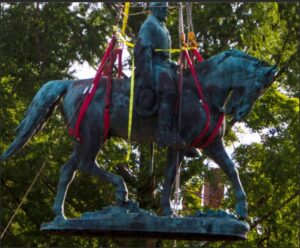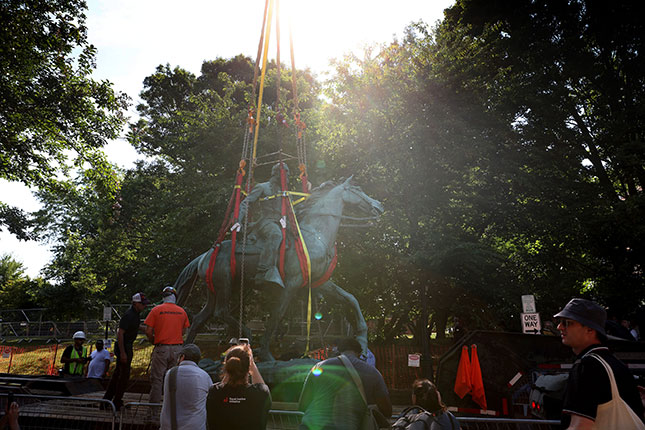 Charlottesville’s hasty—and possibly illegal—destruction of its Robert E. Lee equestrian statue establishes a toxic precedent.by Catesby Leigh
Charlottesville’s hasty—and possibly illegal—destruction of its Robert E. Lee equestrian statue establishes a toxic precedent.by Catesby Leigh
The century-old equestrian statue of Robert E. Lee in Charlottesville, Virginia, has been broken up, and, more likely than not, melted down into bronze ingots by now. But nobody involved in this officially sanctioned act of iconoclasm is saying whether that’s the case. Four weeks after the filing of a petition for injunction intended to prevent the statue’s destruction, the Charlottesville circuit court hasn’t even scheduled a hearing. Charlottesville’s woke excuse for a newspaper of record, the Daily Progress, has been notably incurious about the statue’s current whereabouts or condition.
The Lee equestrian was mainly the work of Henry Merwin Shrady, the sculptor who created the Grant Memorial at the foot of Capitol Hill in Washington. In a way, it was conceived as a peace monument. It showed the Confederate commander in dress uniform, hat at his side, back ramrod straight and with a facial expression of sober resolve. Traveler, his mount, walked with head bowed. Lee had surrendered but retained his dignity in defeat. The expression of resolve reflected a determination that the war be over.
After midnight on December 7, 2021, Charlottesville’s city council hastily—and possibly illegally—approved a resolution to donate the bronze statue, which had been removed from a downtown park in July, to a local African-American heritage center. The center proposed to melt the bronze down so that it could be recast in a “community”-inspired memorial celebrating wokedom’s new world of elevated racial consciousness.
The city council’s approval of the pre-drafted resolution without prior public dissemination is just one legal issue that the two Virginia historical foundations seeking the injunction have raised. In response to the city’s public solicitation, they submitted bids last fall to acquire the Lee statue, along with a likewise-removed Stonewall Jackson equestrian.
The Lee statue has been a popular target for the media, which has portrayed it as the instigator of a notorious 2017 Charlottesville confrontation between white supremacists and counter-protesters. Facilitated by the ineptitude of local and state police, that confrontation culminated in the vehicular murder of a 32-year-old counter-protester. The white supremacists, vastly outnumbered by their leftist antagonists, came to protest a city council vote to relocate the equestrian, and in so doing helped ensure its banishment.
Still, Charlottesville officials, the heritage center, and the center’s key backer, the Memory Project of the University of Virginia’s Democracy Initiative, wasted no time in implementing the plan to destroy the Lee statue once the enabling resolution passed. Within two weeks—as we now know thanks to a conservative Christian blog, the Schilling Report—specialists from a Tennessee bronze foundry dismantled the statue at a city yard out by Interstate 64, loaded it onto a flat-bed trailer, covered it with a tarp, and hauled it down to the foundry. Given the speed with which the statue was cut up and moved, it has probably been melted down.
Charlottesville’s Stonewall Jackson equestrian, which also came down in July, currently languishes in the same city yard. It is slated for inclusion in a fall 2023 Los Angeles exhibit dedicated to “confronting” the South’s Lost Cause mythology and “recontextualizing” displaced Confederate statues by juxtaposing them with contemporary art. Meantime, the nine Confederate statues removed during the tumultuous 2020 Black Lives Matter/Antifa protests in Richmond, Virginia, are domiciled at the River City’s wastewater treatment plant. Richmond’s mayor, Levar Stoney, deemed them public safety hazards. The city’s Monument Avenue, until George Floyd’s killing one of America’s finest statuary venues, was finally stripped of its bronze Lee equestrian in September after a long legal battle. Last month an out-of-state crew dismantled the statue’s majestic, heavily rusticated, 40-foot-tall granite pedestal, hideously defaced with graffiti during the protests—part of outgoing Democratic governor Ralph Northam’s effort to complete the city’s statuary purgation prior to his Republican successor’s January 15 inauguration. The Lee equestrian and the spacious, turfed circle it occupied was deeded to the state in 1890; the other displaced statues, including Jackson and J. E. B. Stuart equestrians, are the property of the city.

Northam conveyed the dismantled Monument Avenue Lee, currently relegated to the grounds of a suburban women’s prison, and the circle to the city. Pedestals for the avenue’s four other Confederate statues remain in place. (The one commemorating Matthew Fontaine Maury portrayed him as a great oceanographer, but he aided the Confederate war effort, so his monument was fair game.) The graffiti on these barren stumps, stark reminders of 2020’s plague of destructive fanaticism, has been smeared over with paint or whitewash. They will probably soon join the statues at the wastewater treatment plant.
Stoney has emerged unscathed from lawsuits and a criminal investigation arising from his statuary campaign, though a judge pronounced it “wrongful.” The mayor proposes to give the banished monuments to the state’s black history museum, with the museum sharing responsibility for their conservation and presentation with the older and better-known Valentine Museum. Both are located in the River City, but neither has the resources or space to maintain and exhibit the monuments, so their future is uncertain. Equally uncertain is what actions, if any, Virginia’s newly inaugurated governor, Glenn Youngkin, will take to preserve the state’s monumental heritage. During an unquestionably astute political campaign in which he focused on clear-cut issues such as excessive COVID mandates, “anti-racist” indoctrination in schools, and respect for law enforcement, the former Carlyle Group executive refrained from criticizing the removal of Confederate monuments, instead endorsing their transfer to museums and battlefields.
But the destruction of Charlottesville’s Lee sets an extremely toxic precedent. A Republican state senator, Bryce Reeves, has denounced it as illegal. It remains to be seen whether he and the newly elected Republican attorney general, Jason Miyares, will find a way to penalize the city. This would be good politics, both because Charlottesville skated on thin legal ice in approving the monument’s destruction and because the city and the University of Virginia are bastions of political lunacy. “Charlottesville: The beautiful-ugly it is,” Nikuyah Walker, the mayor who signed off on the Lee statue’s destruction, proclaimed in a social media post last year. “It rapes you, comforts you in its cum stained [sic] sheet and tells you to keep its secrets.” Walker, a racial-grievance activist whose term ended on December 31, has helped make the city uglier in more ways than one.
Youngkin might hope for the Confederate monument controversy to go away. It won’t, even though a petition for U.S. Supreme Court review of the Richmond Lee monument case filed this week looks like a long shot. The controversy will be playing out for a long time. It entails complex cultural and historical issues that the simplistic pieties of Antifa, BLM, and legions of woke advocates masquerading as educators couldn’t possibly accommodate. But when Richmonders, along with denizens of other Southern cities whose public spaces have been similarly degraded, recover their senses, they might just want their old monuments back. Especially when they are confronted with the highly politicized postmodern inanities that are likely to take their place.
Of course, Richmonders should aspire to more than the restoration of the status quo ante. They should want to see new civic landmarks that embody the advent of a more just social order; that do more than lampoon or apologize for the past; that build on a rich civic-art heritage. In short, they should seek new landmarks that inspire.
But the immediate task at hand is for Virginia leaders to make sure that there will be no repeats of these assaults on historic monuments—and, above all, no repeats of the government-sanctioned iconoclasm in which Charlottesville has indulged.
Catesby Leigh writes about public art and architecture and lives in Washington, D.C. This article has been republished with permission from City Journal.

Leave a Reply
You must be logged in to post a comment.